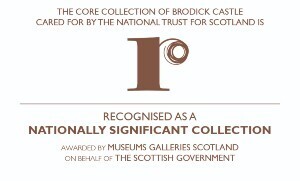Collections Diaries – Princess Marie’s Napoleonic coins and medals at Brodick Castle
When I joined the Trust as curator for Ayrshire & Arran and Dumfries & Galloway in spring 2017, the multi-million-pound project to upgrade the fire suppression system at Brodick Castle was well underway. The calm, opulent interiors in the castle that I had seen on previous visits were now a hive of activity. Some of the most delicate items were being wrapped and crated for storage off-site, while larger items were being wrapped and moved to safe areas within the building. At this point I had no idea that nestled among crisp leaves of acid-free tissue paper in the stores above me was a set of unassuming red boxes containing some of the Trust’s potentially most internationally significant items.
The Trust had known about the coin and medal collection at Brodick for decades, but it wasn’t until a more detailed inventory of every item in the castle was completed that the full extent of the collection and its possible rarity and importance was realised. The collection consists of over 700 coins and medals: most are kept in bespoke monogrammed boxes, with a few wrapped in paper with historical inscriptions that suggest they belonged to Stéphanie de Beauharnais (1789–1860).
Stéphanie was born at the Palace of Versailles, at the beginning of the French Revolution, to Claude de Beauharnais, 2nd Count des Roches-Baritaud (1756–1819) and Claudine Francoise de Lezay (1767–91). In 1796, Stéphanie became linked with Napoleon Bonaparte when he wed Joséphine de Beauharnais (1763–1814), who had previously been the wife of Stéphanie’s father’s cousin. As part of his attempts to secure a political alliance with the Prince-elector of Baden but lacking a legitimate heir, Napoleon adopted Stéphanie and named her ‘Princesse Française’. She was married to the Grand Duke of Baden’s grandson, Crown Prince Karl Ludwig Friedrich (1786–1818), in 1806. The couple had five children, including Princess Marie Amelie (1818–88), who married William (1811–63), the future 11th Duke of Hamilton, in 1843.
After Stéphanie’s death in 1860, we think the collection passed to her youngest daughter Marie. The nine monogrammed boxes contain many extremely important items, including: sets of gold, silver and bronze medals relating to the Emperor Napoleon; a series of 19th-century bronze medals commemorating famous historical figures; 15th- and 16th-century English and European gold and silver coins; ancient Greek and Roman coins; and a collection of Islamic coins. Some of the coins, such as a membership medal for the Duke of Hamilton from the Glasgow Athenaeum (which was founded in 1847 as an institution for adult education and recreation), were obtained at other times.
It’s not clear how many of the coins and medals belonged to Princess Marie, but it was immediately obvious to the experts that we consulted that the collection was extremely interesting and needed to be explored in more detail. For example, previous research on the medals struck to commemorate the marriage of Stéphanie and Crown Prince Karl only refers to these medals in bronze and silver, suggesting the two gold medals in our collection are very rare, if not unique.
As well as wanting to learn more about the collection and its historical roots, it was important that we also look at improving the storage to protect the coins and medals for future generations. The monogrammed boxes are interesting in their own right but they don’t provide the ideal storage conditions. Some coins have areas of verdigris (a bluish-green patina that forms on copper or brass due to oxidation) while others, particularly the softer gold coins, are (very!) slowly being crushed by the weight of the layers above them. Working with an external conservator, we’ll review the condition of all 700+ items and, if necessary, arrange for them to receive conservation treatment.
The collection at Brodick is Recognised as Nationally Significant, meaning that it’s considered as historically and culturally important as the collections held in Scotland’s national museums and galleries. The scheme is intended to ‘celebrate, promote and invest in’ world class collections and, after lots of hard work in collaboration with colleagues in the conservation and fundraising teams, we were lucky to receive a grant from Museums Galleries Scotland to complete the cataloguing, conservation and display of the collection.
Like everyone else this year, COVID-19 has had an impact on our plans but the project is progressing. We’re beavering away behind the scenes tagging thousands of digital images, working remotely with conservators and experts to catalogue and research the collection more fully. We’re also exploring new ways to display parts of the coin and medal collection for the first time and thinking about how we can integrate this into the castle experience, and online, to provide more insight into Princess Marie’s life and family history.
This project is like a miniature version of everything we do in the curatorial, collections and conservation teams, and draws on various strands of expertise and knowledge. Being able to explore the lives and collections of fascinating people like Princess Marie of Baden, working with knowledgeable colleagues and external specialists, and then finally finding opportunities to share these stories with our visitors and staff is the most rewarding part of my job.
The new display of the coins and medals at Brodick Castle is still in development but I hope you’ll all be able to enjoy it soon!
I’m extremely grateful to everyone who has contributed to this project so far, internally and externally, and to Museums Galleries Scotland for their support. Find out more about MGS and the Recognition scheme


Stay in touch
Be the first to hear about our latest news, get inspiration for great days out and learn about the work we do for the love of Scotland.